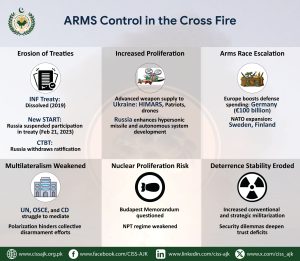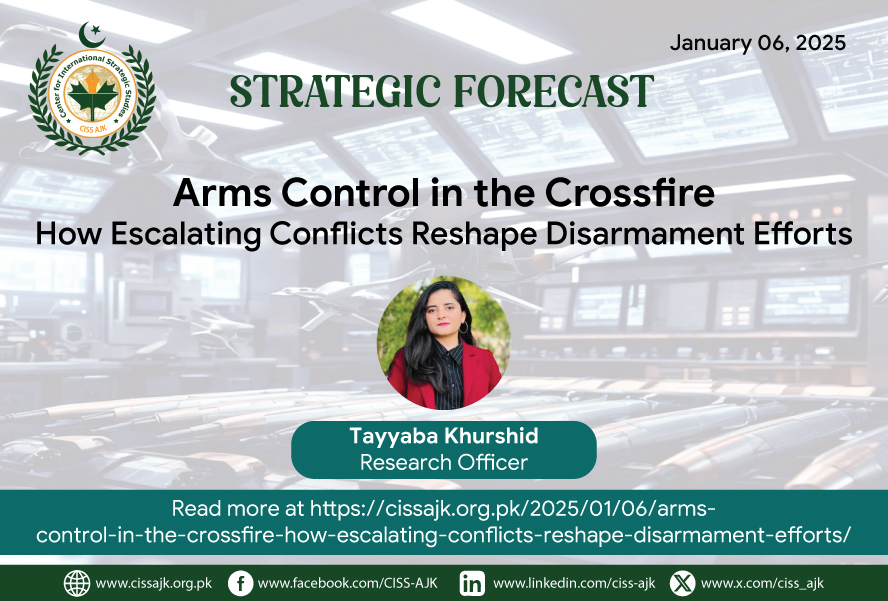 The Ukraine war has brought the complexities of arms control into stark relief, illustrating how conflict intensity can both undermine and redefine the international arms control framework. As one of the most significant military confrontations of the 21st century, the war has influenced bilateral arms control efforts between US and Russia, global disarmament regimes, regional arms races, and the balance of deterrence. The war demonstrates how conflict intensity undermines global arms control efforts, exacerbates arms proliferation, and pose challenge to the international disarmament frameworks. The conflict has strained existing treaties, fueled advanced weapon proliferation, and reignited regional arms races, complicating future disarmament efforts. To address these issues restoring dialogue among major powers, revitalizing multilateral institutions, and adopting innovative frameworks to regulate emerging technologies is crucial.
The Ukraine war has brought the complexities of arms control into stark relief, illustrating how conflict intensity can both undermine and redefine the international arms control framework. As one of the most significant military confrontations of the 21st century, the war has influenced bilateral arms control efforts between US and Russia, global disarmament regimes, regional arms races, and the balance of deterrence. The war demonstrates how conflict intensity undermines global arms control efforts, exacerbates arms proliferation, and pose challenge to the international disarmament frameworks. The conflict has strained existing treaties, fueled advanced weapon proliferation, and reignited regional arms races, complicating future disarmament efforts. To address these issues restoring dialogue among major powers, revitalizing multilateral institutions, and adopting innovative frameworks to regulate emerging technologies is crucial.
The war has placed immense strain on the existing arms control architecture, which was already fragile before the conflict began. The dissolution of the Intermediate-Range Nuclear Forces (INF) Treaty in 2019 and the strained New START Treaty between the United States and Russia had already weakened the global arms control regime. As both the sides accuse each other of violation of the treaty and use it as a pretext to withdraw from these agreements. On February 21, 2023, the Russia announcement to suspend NEW Start Treaty also shows the lack of trust between Russia and US. Putin also pointed out in a conference that the “US intent of causing strategic defeat to Russia and dialogue on New Start treaty cannot happen at the same time”. Linking the agreement with geopolitical realities, Senior Russian diplomat and New START negotiator Anatoly Antonov explained, “We have warned that arms control cannot be isolated from geopolitical realities. In the current circumstances we consider it unjustified, untimely and inappropriate to invite the US military to our strategic facilities.” Along with that, the consensus on NPT is blocked by Russia and Russia has also withdrawn from its ratification of Comprehensive Test Ban Treaty highlighting war’s impact on overall arms control negotiations.
Amidst the already simmering tension between the two sides, the war further undermines decades of progress in nuclear arms reduction and erode the principle of deterrence stability. Simultaneously, the U.S. and NATO’s response, including bolstering Ukraine’s conventional military capabilities, has escalated arms transfers in the region, sidestepping traditional arms control frameworks. The war in Eastern Europe has fueled the proliferation of advanced weaponry, as western nations race to supply Ukraine with the tools needed to resist continued Russian advancements. Western countries have provided Ukraine with state-of-the-art systems, including HIMARS, Patriot missile batteries, and advanced drones. According to Bureau of Political-Military Affairs, US Department of state US has provided approximately $61.4 billion in military assistance since Russia launched its invasion of Ukraine on February 24, 2022. These efforts introduce risks to arms control by increasing the availability and accessibility of sophisticated weaponry in the region.This trend is not limited to Ukraine. Russia’s reliance on advanced weapons has also been improved, including hypersonic missiles and autonomous systems. The unchecked spread of these technologies complicates future disarmament efforts and undermine any step towards resolution of conflict.
War in Europe has also reignited arms race, where nations are increasing their defense spending and modernizing their arsenals. Germany’s historic decision to allocate €100 billion to its military marks a shift in European defense policy. Similarly, Sweden and Finland’s bids to join NATO reflect growing concerns about regional security and the need for collective deterrence. This militarization, while understandable given the circumstances, runs counter to global arms control objectives. Increased investment in conventional and strategic capabilities among European states can lead to an international security dilemma, wherein efforts to enhance national security inadvertently provoke similar responses from adversaries. This has undermined trust and complicates negotiations for future arms control agreements.
Challenges to Multilateralism
Multilateralism has also faced challenges as arms control efforts are eroded as a consequence of war. Institutions like the United Nations and the Organization for Security and Co-operation in Europe (OSCE) have struggled to mediate effectively in the conflict, reflecting the broader polarization of the international system. Russia’s position as a permanent member of the UN Security Council complicates collective action, while NATO’s direct involvement on one side of the conflict limits its role as a neutral mediator. The lack of progress in forums like the Conference on Disarmament underscores the difficulty of achieving consensus in an increasingly divided world. Without robust multilateral mechanisms, arms control efforts risk becoming fragmented and ineffective, leaving states to prioritize unilateral or bloc-based approaches.
The debates about the role of nuclear weapons in ensuring security has emerged again. Ukraine’s relinquishment of its nuclear arsenal in the 1990s under the Budapest Memorandum, in exchange for security guarantees, has been a focal point of this discussion. Russia’s invasion has called into question the reliability of such guarantees, potentially encouraging other nations to pursue or retain nuclear capabilities as a hedge against aggression. This shift undermines non-proliferation efforts and could trigger a new wave of nuclear proliferation, especially in regions where security guarantees are perceived as insufficient. The erosion of the Nuclear Non-Proliferation Treaty (NPT) regime, combined with the lack of progress on disarmament by nuclear-armed states, exacerbates these risks.
Addressing the impact of the Ukraine war on arms control requires a multi-dimensional approach. First, re-establishing dialogue between major powers is essential in rebuilding trust and reducing the risk of escalation. Renewing commitments to treaties like New START and initiating new arms control negotiations could serve as confidence-building measures.
Along with that, strengthening the role of multilateral institutions is critical for maintaining a rules-based international order. Reinvigorating the OSCE and the UN’s disarmament machinery could provide a platform for dialogue and conflict resolution. Third, innovative approaches to arms control must be explored, including frameworks for regulating emerging technologies like autonomous weapons and hypersonic missiles. Transparency measures, confidence-building initiatives, and verification mechanisms could help mitigate the risks posed by these advancements. Finally, regional security arrangements should be prioritized to address the unique challenges faced by Europe in the wake of the Ukraine war. Initiatives that balance deterrence with diplomacy, such as confidence-building measures and arms reduction agreements, could help stabilize the region and create conditions for long-term peace.
The Ukraine war highlights the indirect proportionality between conflict intensity and arms control. As the war in Ukraine escalated, the trust deficit between US and Russia has increased and arms control negotiations have been completely sidelined.
Author
Tayyaba Khurshid, Research Officer at Center for International Strategic Studies, AJK.

